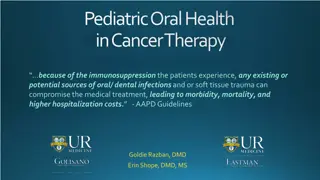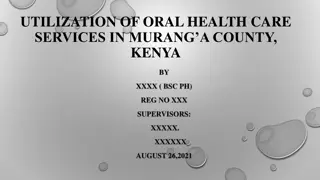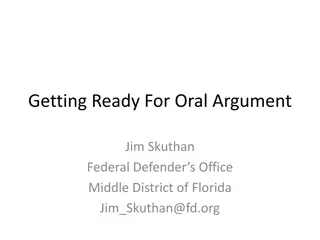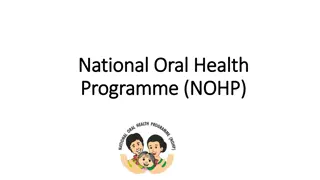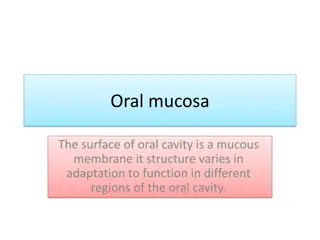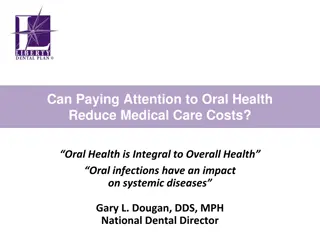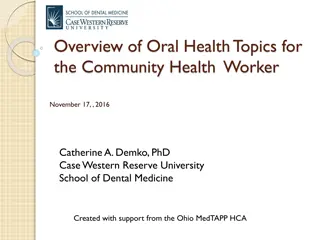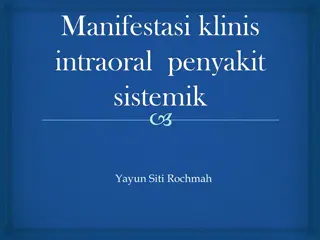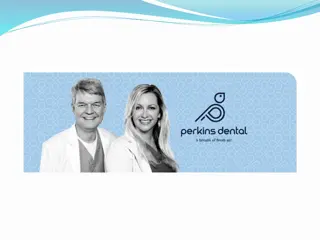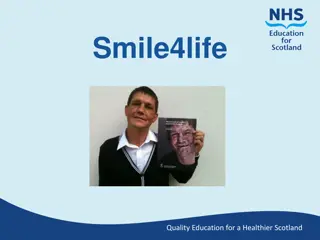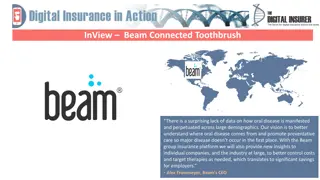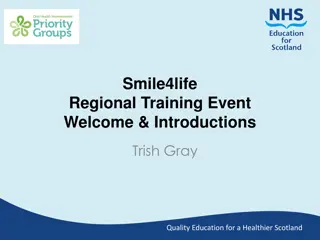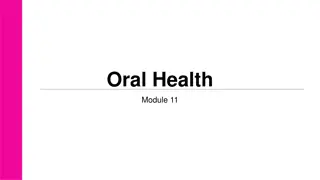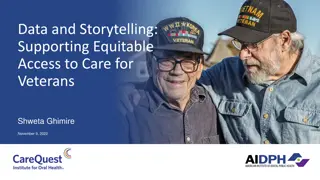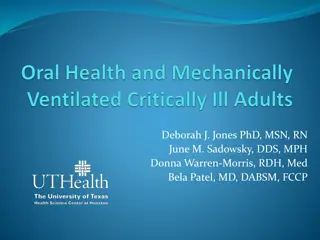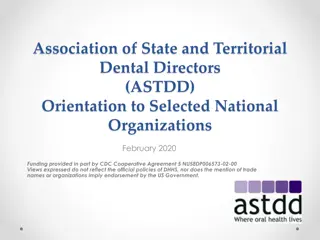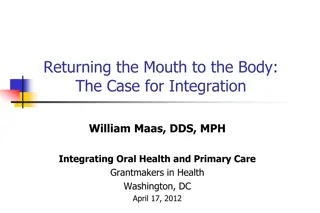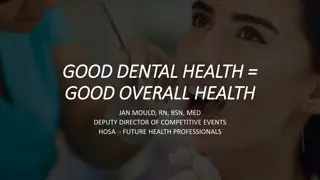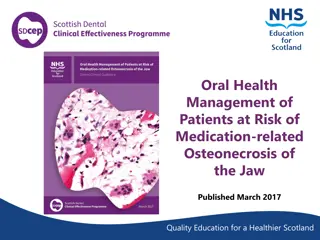The Role of Federal Agencies in Promoting Oral Health: An Overview
This presentation delves into the role of federal agencies, particularly the US Department of Health and Human Services (HHS), in advancing oral health initiatives. It covers key agencies, the FY 2018 budget, regional offices, and goals for improving oral health outcomes in children and adults. Insights into HHS structure, operating divisions, and strategic activities are also provided.
Download Presentation

Please find below an Image/Link to download the presentation.
The content on the website is provided AS IS for your information and personal use only. It may not be sold, licensed, or shared on other websites without obtaining consent from the author. Download presentation by click this link. If you encounter any issues during the download, it is possible that the publisher has removed the file from their server.
E N D
Presentation Transcript
The Role of the Federal Agencies and Regional Offices in Promoting Oral Health OH 2020 Network - Take 20 April 3, 2018 Marcia K. Brand, Ph.D. Senior Advisor, DentaQuest Foundation
This Presentation 2 Overview of HHS and its structure The key HHS Agencies and their oral health activities The FY 2018 federal budget for oral health activities (preliminary) Engaging HHS The role of the Regional Offices Where to learn more about selected HHS and oral health activities
OH 2020 Goals: Which HHS Offices/Agencies Might Help In This Work? 3 Goal 1 Eradicate dental disease in children. With the closing of disparity gaps, 85% of children reach age 5 without a cavity Goal 2 Incorporate oral health into the primary education system. The 10 largest school districts have incorporated oral health into their systems Goal 3 Include an adult dental benefit in publicly funded health coverage. At least 30 states have an extensive Medicaid adult dental benefit. Medicare includes an extensive dental benefit. Goal 4 Build a comprehensive national oral health measurement system A national and state-based oral health measurement system is in place Goal 5 Integrate oral health into person-centered healthcare. Oral health is integrating into at least 50% of emerging person-centered care models. Goal 6 Improve the public perception of the value of oral health to overall health. Oral health is increasingly included in health dialogue and public policy.
Overview of the US Department of Health and Human Services (HHS) 4 Secretary Chief executive officer, political appointee, member of the Cabinet. Secretary Alex Azar. Surgeon General Leader of the US Public Health Service Commissioned Corps, leading spokesperson on matters related to public health; appointed by the President, with Senate advice and consent. Dr. Jerome Adams. Assistant Secretaries, Dep Secs and P-DASHs! (Health, Administration, Planning and Evaluation, Preparedness and Response, Public Affairs) Office of Minority Health, Office of Women s Health HHS activities at the Department level (StaffDivs) develops strategic plans (e.g., Healthy People 2020, HP 2030), HHS strategic plan 2018 2012 develops policies and regulations conducts public health assessments develops and submits budgets to OMB implements programs (grants) authorized by Congress.
Operating Divisions (Opdivs) 5 Centers for Medicare and Medicaid Services (CMS) Food and Drug Administration (FDA) Health Resources and Services Administration (HRSA) Indian Health Services (IHS) National Institutes of Health (NIH) Substance Abuse and Mental Health Services Administration (SAMHSA) Administration for Children and Families (ACF) Administration for Community Living (ACL) Agency for Healthcare Research and Quality (AHRQ) Agency for Toxic Substances and Disease Registry (ASTDR) Centers for Disease Control and Prevention (CDC)
Current HHS-wide Oral Health Activities 6 New HHS Strategic Plan 2018-2022 In 2013 2014, more than 14 percent of children had untreated dental decay in their primary or permanent teeth, and only 43.1 percent of children, adolescents, and adults had used the oral healthcare system in the last year. The Department is working to promote oral health through the following strategies: Strengthen oral health literacy, and integrate oral health awareness into clinics, early childhood settings, and social service agencies Promote dental screenings and preventive oral care for children and adolescents US Public Health Service Oral Health Coordinating Committee HHS and other services cross-governmental workgroup Earlier Oral Health Strategic Framework (2014 2017) Collective actions to realize the HHS s oral health vision and eliminate oral health disparities Goals were closely aligned with OH 2020 goals
Current HHS-wide Oral Health Activities 7 Healthy People 2020 Goals (examples); currently working on 2030; similar to OH 2020 Goal 1: Eradicate dental disease in children. OH-1 Reduce the proportion of children and adolescents who have dental caries experience in their primary or permanent teeth OH-2 Reduce the proportion of children and adolescents with untreated dental decay OH-3 Reduce the proportion of adults with untreated decay OH-4 Reduce the proportion of adults who have ever had a permanent tooth extracted because of dental caries or periodontal disease OH-6 Increase the proportion of oral and pharyngeal cancers detected at the earlies age OH-8 Increase the proportion of low-income children and adolescents who received any preventive dental service during the past year OH-10 Increase the proportion of local health departments and FQHCs that have an oral health program
Key Agencies: Centers for Disease Control and Prevention (CDC) 8 Division of Oral Health works to improve the oral health of the nation and reduce inequalities in oral health by: Helping states improve their oral health programs Develop a state oral health plan Develop and work with state oral health coalitions Training and resource development (Oral Health Resources Web site) Extending the use of proven strategies to prevent oral disease; encouraging the effective use of fluoride products and community water fluoridation and promoting greater use of school-based and linked dental sealant programs Surveillance - enhancing efforts to monitor oral diseases (dental caries and periodontal infections); similar to OH 2020 Goal 4 re: measurement Contributing to the scientific knowledge-base regarding oral health and disease Guiding infection control in dentistry FY 2018: $19 billion FY 2017:
Key Agencies: Centers for Medicare and Medicaid Services (CMS) 9 Oral Health Efforts: Works to improve the collection and analysis of data and quality measures related to the delivery of Medicaid and CHIP oral health services (OH 2020 Goal 4 Measurement). Sponsors the Oral Health Initiative, asking each state to increase the proportion of Medicaid children receiving preventive dental services by 10 percentage points by 2018. Annually reports state progress on the oral health quality measures in the child core set of health-care quality measures PDENT: proportion of children ages 1 20 enrolled in Medicaid/CHIP who received a preventive dental service. SEAL: Proportion of children ages 6 9 enrolled in Medicaid/CHIP who received a sealant on a permanent molar. Maintains and promotes the use of the national Insure Kids Now Medicaid/CHIP dentist locator. Provides technical support to three States testing value-based payment approaches to oral health services in Medicaid. Supports the validation of two dental measures (sealants and continuity of care) for inclusion in electronic health records. FY 2018: $4 billion (for administration) FY 2017: $4 billion
Key Agencies: Health Resources and Services Administration (HRSA) 10 Health center program (1,400 FQHCs) increases access to quality primary health care services, including oral health services, for medically underserved populations. Most health centers provide dental services on-site, or by paid referral In 2016 additional $156 million investment in oral health In 2016 health centers provided more than 14 million dental visits, an increase of 56% since 2010 Supports school-based oral health care FY 2018: $5.4 billion (mandatory and discretionary)FY 2017: $4,997,590,000 Supports oral health care for people living with HIV/AIDS through the Ryan White/HIV/AIDS Bureau FY 2018: $13.1 million FY 2017: $13.09 million
Key Agencies: HRSA (cont.) 11 Supports maternal and child health programs that promote oral health Title V (state block grants) FY 2018: $652 million FY 2017: $642.1 million Perinatal and Infant Oral Health Quality Improvement Initiative reduce the prevalence of oral disease in pregnant women and infants through improved access to high quality care. 16 state projects Learning collaborative coordinated by the Center for Oral Health Integration and Improvement, includes the National Maternal and Child Oral Health Resource Center, ASTDD and FrameShift Group
Key Agencies: HRSA (cont.) 12 Engages other providers in oral health workforce development Supports the Integrating Oral Health and Primary Care Practice Initiative oral health core clinical competencies for primary care providers Supports the National Center for Interprofessional Practice and Education promotes interprofessional practice and team-based care Supports the National Network for Oral Health Access Supported the development of oral health clinical competencies for primary care providers Designates Dental HPSAs (health professions shortage areas) Supports other policy work, such as National Academy of Medicine studies (IOM reports in 2011) Supports an Oral Health WorkforceResearch Center (SUNY-Albany)
Key Agencies: HRSA (cont.) 13 Supports dental workforce development grants (Title VII) general dentistry (not less than $10 million) pediatric dentistry (not less than $10 million) dental faculty loan repayment (not less than $2 million) dental hygiene dental public health State Oral Health Workforce grants FY 2018: $40,673 million FY 2017: $36,587million National Health Service Corps (loan repayment in exchange for service) FY 2018: $415 million (include discretionary and mandatory) FY 2017: $288.6 million Area Health Education Centers FY 2018: $38,250 million FY 2018: $30,177 million
Key Agencies: HRSA (cont.) 14 National Organizations for State and Local Officials (NOSLO) - cooperative agreement Works with the National Conference of State Legislatures (NCSL), Association of State and Territorial Health Officials (ASTHO), and other national organizations to develop oral health resources Federal Office of Rural Health Policy Rural Health Care Services Outreach (not less than $8 million) and Rural Health Network Development grant programs (not more than $15.1 million) Rural Oral Health Toolkit Up $100 million in FY 2018 to address the opioid crisis; also to support NHSC For more information about HRSA: https://www.hrsa.gov/oral-health/index.html
Key Agencies: Indian Health Service (HIS) 15 Oral Health Activities Provides oral health assessment and fluoride varnish application training to primary care providers and other staff Supports an Early Childhood Caries Collaborative, promotes childhood oral health and the application of dental sealants Provides direct care to AI/AN patients or contracts with tribal organizations to provide dental care IHS Dental Strategic plan comments through May 31, 2018 IHS Division of Oral Health (Rockville, MD central office, and regional offices) FY 2018: $195.3 million (up $13 million) FY 2017: $182.3 million
Additional Support for Oral Health 16 Administration for Community Living encourages the Aging Services Network to engage in oral health promotion and disease prevention interventions for older adults and people with disabilities Oral Health Community Guide FY 2018: $2.2 billion (up $178 million) FY 2017: $2.022 billion Administration for Children and Families promotes dental homes for Early Head Start and Head Start children NIH conducts research through the National Institute of Dental and Craniofacial Research FY 2018: $447 million (up $22 million) FY 2017: $425 million Other NIH Institutes National Institute of Child Health and Human Development National Institute on Minority Health and Health Disparities National Cancer Institute
Engaging HHS and the Agencies 17 Apply for grant support for your project Serve as a grant reviewer; best way to learn grant writing! Participate on advisory panels (watch for calls , let the Executive Secretary know that you are interested) Sign up for email updates and newsletters (e.g., HRSA, Bureau of Primary Health Care and the Bureau of Health Workforce; Federal Office of Rural Health Policy) Meet with administration officials to describe a program, promising practice, effort to address an unmet oral health need, OH 2020 and its goals HHS Washington ACF, ACL - Washington CMS Baltimore and Washington HRSA, IHS, SAMHSA, AHRQ headquarters in Rockville, MD CDC - Atlanta Submit comments on regulatory proposals Write letters to inform, in support or to express concerns!
Engaging HHS Closer to Home! Regional Offices 18 Regional Directors like the Secretary, but in the region Cross-Agency engages HHS more broadly, serves as convener Portfolio? Receptive a place to start Can you partner in some capacity? Invite to your oral health coalition meetings? Ask to serve as a regional convener? Regional Health Administrators like the Surgeon General, but in the region; clinical focus Career staff assigned to Regions HRSA regional HRSA administrator CMS regional CMS administrator SAMHSA, ACF (focus on Head Start), ACL
OH 2020 Goals: Which HHS Offices/Agencies Might Help In This Work? 20 For all goals: Secretary, Surgeon General, Assistant Secretary for Health, Regional Directors, Regional Health Administrators Goal 1 Eradicate dental disease in children. (ACF, ACL, CDC, CMS, HRSA, IHS, NIH) Goal 2 Incorporate oral health into the primary education system. (ACF, CDC, HRSA, IHS) Goal 3 Include an adult dental benefit in publicly funded health coverage. (ACF, ACL, AHRQ, CDC, CMS, HRSA, IHS) Goal 4 Build a comprehensive national oral health measurement system. (AHRQ, CDC, CMS, HRSA, IHS, NIH) Goal 5 Integrate oral health into person-centered healthcare. (ACF, ACL, CDC, CMS, HRSA, IHS, NIH, SAMHSA) Goal 6 Improve the public perception of the value of oral health to overall health. (ACF, ACL, AHRQ, CDC, CMS, HRSA, IHS, NIH, SAMHSA)
Additional Resources 21 Learning more about the regional offices: https://hhs.gov/about/agencies/iea/regional- offices/index.html Finding out about grants: https://www.hhs.gov/grants/index.html Oral health workforce research center: http://www.oralhealthworkforce.org/ For more information about HRSA s oral health programs: https://www.hrsa.gov/oral-health/index.html ACL s Oral Health Community Guide: https://www.acl.gov/programs/health-wellness/oral-health
A few additional thoughts 22 Should we create a 10 HHS region strategy and use our OH 2020 members in their respective regions to engage each of the Regional Directors around oral health? Should we identify key HHS leaders in Staff/divs (Secretary s office) and engage them around oral health? Should we identify key leaders from the Op/divs (Operating Divisions - Agencies) to engage around goals that their agency might address? Should we see if we could set up a Take 20 with individual members of the USPHS Oral Health Coordinating Committee (OHCC), asking them to talk about their particular agency? Should we try to hold a webinar with the OHCC as a whole, and tell them about our OH 2020 work or attend one of their meetings?
Let me know if you have additional ideas or questions.. 23 Marcia.brand8@gmail.com








